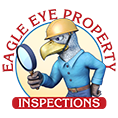AboutFire Extinguisher Inspections
Fire Extinguisher Inspections by Eagle EyeFire Extinguisher Inspections by Eagle Eye
Fire extinguishers are small metal canisters that contain compressed gas (usually nitrogen) that, when activated, propel a directed spray of flame-retardant chemicals. Fire extinguishers are only effective if building occupants understand where and why they are used. A basic yet not exhaustive way to properly use a fire extinguisher is to PASS. That is to, A basic way to properly use a fire extinguisher PASS. That is to,
• PULL
PULL THE PIN AT THE TOP OF THE EXTINGUISHER. THE PIN RELEASES A LOCKING MECHANISM AND WILL ALLOW YOU TO DISCHARGE THE EXTINGUISHER
• AIM
AIM AT THE BASE OF FIRE, NOT THE FLAMES. THIS IS IMPORTANT – IN ORDER TO PUT OUT THE FIRE, YOU MUST EXTINGUISH THE FUEL.
• SQUEEZE
SQUEEZE LEVER SLOWLY. THIS WILL RELEASE THE EXTINGUISHING AGENT IN THE EXTINGUISHER. IF THE HANDLE IS RELEASED, THE DISCHARGE WILL STOP.
• SQUEEZE
SWEEP FROM SIDE TO SIDE. USING A SWEEPING MOTION, MOVE THE FIRE EXTINGUISHER BACK AND FORTH UNTIL THE FIRE IS COMPLETELY OUT.
Remember to operate the extinguisher from a safe distance, several feet away, and then move towards the fire once it starts to diminish. Be sure to read the instructions on your fire extinguisher – different fire extinguishers recommend operating them from different distances. Remember: Aim at the base of the fire, not at the flames
There are different types of fire, and for every type of fire there is a class of fire extinguisher that will effectively help when turning off the type of fire that it is created for.
Class A. canisters are for wood, paper, cloth, trash and many other ordinary materials. Mostly come about from ordinary combustibles, such as wood and paper.
Class B. canisters are for gasoline, oil, paint and other flammable liquids. These fires result from combustible liquids, such as kerosene, gasoline, oil, and grease.
Class C. canisters may be used on fires involving live electrical equipment without danger to the operator. These result from the combustion of circuit breakers, wires, outlets, and other electrical devices and equipment.
Class D. canisters are more for combustible metal and combustible alloys. These types of fires typically take place in chemical laboratories and rarely do they happen in other environments.
Class K. Canisters are used for cooking media, such as vegetable or animal oils and fats such as lard. These types of fires consume vegetable oils, animal fats, and generally happen in kitchens. Fire extinguishers should be inspected on a regular basis to ensure they will properly work and fulfill their purpose should an emergency occur. Eagle Eye has the experience to perform these types of inspection on quarterly and year inspection basis. Whether it is a onetime inspection during a commercial property inspection, or a recurring inspection for a management/owner company.

